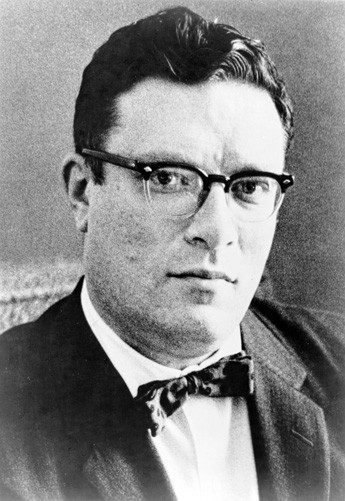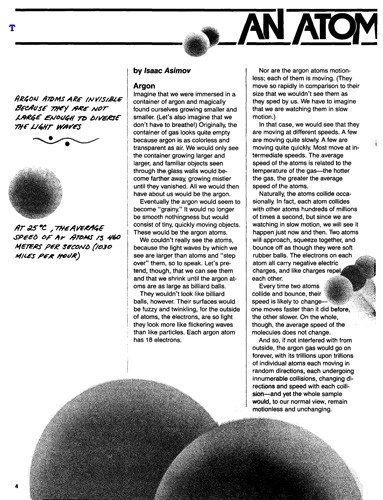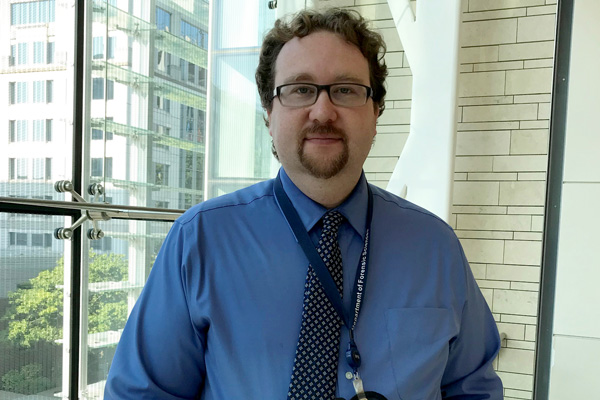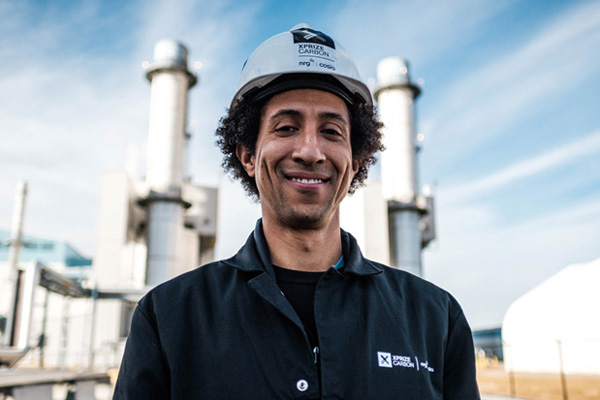
Downloads:
Isaac Asimov imagined a world of robots and humans. In his 1940 short story “Robbie,” Asimov describes a world in which robots are fully integrated into society, even as favored playmates for children. As the story goes, one day, “Robbie” the robot is sent away by the parents of a young girl, who are concerned about her social development. The little girl, Gloria, never stops looking for Robbie, and in the climactic scene, Robbie saves Gloria from being struck by a moving vehicle when no one else could. “Robbie” is an optimistic foretelling about the relationship between people and machines in a not-too-distant future.
In addition to being a highly regarded writer of science fiction, Isaac Asimov was also a chemist. He was a professor of biochemistry at Boston University, co-wrote a textbook, and authored many articles on popular science. In October 1983, Asimov wrote an article titled “Atomic Tour” for the very first issue of ChemMatters. His article invites us to imagine how we would experience atoms and molecules if we shrunk ourselves down to a nano scale.


As we celebrate the 40th anniversary of ChemMatters magazine, we stand on the edge of a new great age in technological revolution. Large language models, like those that power ChatGPT or Google’s Bard, are pushing the traditional limits of computing.
Large Language Models (often abbreviated as LLMs) are computer algorithms that process huge amounts of written information and predict which words are most likely to follow based on patterns. It’s like the auto complete you probably use on your smart phone, but on a much larger scale that is rapidly increasing.
But, then again, you probably already knew that.
Maybe you’re using it right now to suggest a fire Spotify playlist, or rewrite Macbeth in the style of "SpongeBob SquarePants," or dash off an eloquent letter to the editor of ChemMatters in Japanese.
With the advent of Artificial Intelligence (AI) tools like ChatGPT, we may be able to automate things we never thought possible. And its utility isn’t limited only to amusement. From essays to lab reports, to practice problems and beyond, LLMs put tremendous generative power at our fingertips.
Proponents say technologies such as ChatGPT will automate simple processes, train us to use tools of the future, or even unlock our full potential. Critics say AI might discourage writing proficiency, stifle creativity, and make us more susceptible to bias or plagiarism.
No matter how we balance our hopes and fears, AI is predicted to have a huge impact on society. In 2020, the US Government formed the National Artificial Intelligence Initiative Office. In a speech in June 2023, President Joe Biden explained his understanding of AI saying, in part, “I don’t think ever in the history of human endeavor has there been as fundamental a potential technological change as is presented by Artificial Intelligence.” Analysts see a big future for AI in business, too. Calling it the next “productivity frontier,” consulting firm McKinsey estimates that AI could add trillions of dollars in value to the global economy in the coming decades.
Should we embrace the use of AI in chemistry in other fields? Will it accelerate our rate of innovation, or might it distance us from foundational skills? Does it carry with it the promise of progress, or will it mirror our worst impulses and the shadowy fringes of society?
Is Asimov’s optimism about our future well founded or is it misplaced? The matter is open for discussion.
REFERENCES
Yahoo Finance. Biden: AI Is ‘Staggering.’ YouTube, June 8, 2023: https://www.youtube.com/watch?v=LpI4JIIDx8w [accessed Aug 2023].





